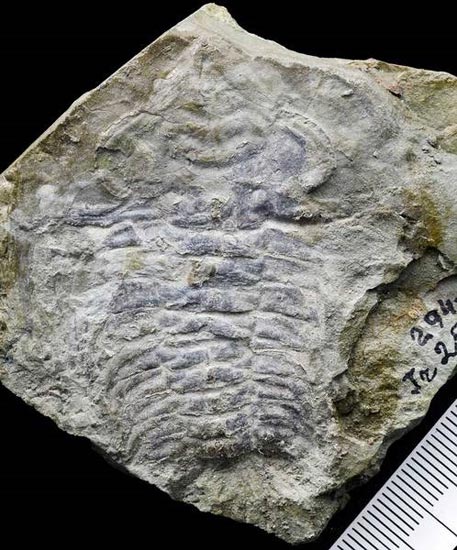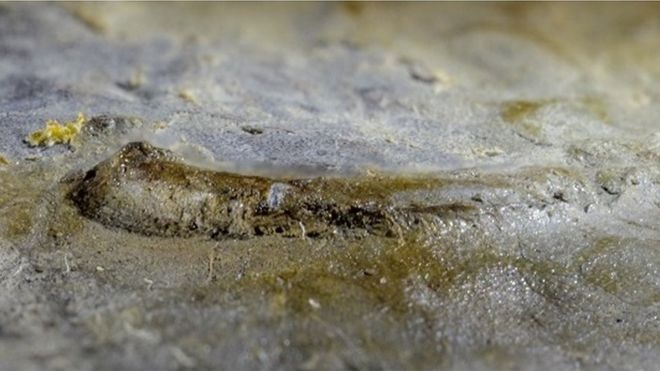Insight into Evolution of the Compound Eye
A team of international scientists including researchers from Cologne University, Estonia and the University of Edinburgh have been looking into the evolution of the first eyes by studying the remarkably well-preserved remains of an eye from a trilobite that lived in the sea more than half a billion years ago. The trilobite to which it belongs (Schmidtiellus reetae), comes from a fossiliferous zone where the first complete, large organisms appear in the fossil record. As a consequence of this, it is probably the oldest record of an ophthalmic system likely to be discovered.
Unlike modern compound eyes, the eye of this trilobite had no lens. The fossil is estimated to be around 530 million years old.
The Trilobite Fossil Providing an Insight into the Evolution of Eyesight

Picture credit: G. Baranov (University of Cologne)
Schmidtiellus reetae – Trilobite Fossil from Estonia
The research team, which included Dr Brigitte Schoenemann (University of Cologne) and her colleagues Helje Pärnaste (Tallinn, Estonia) and Euan Clarkson (Edinburgh University), examined the specimen (S. reetae) and examined the cellular structure of the compound eye.
The CollectA Prehistoric Life model range contains replicas of prehistoric invertebrates including a trilobite.
To view this range: CollectA Age of Dinosaurs Popular Prehistoric Life Models.
This remarkable fossil shows how the eye was constructed and from this the team could infer what level of vision the arthropod had. As well as looking at similarities with extant arthropods, the researchers were keen to see how the trilobite eye differed in structure and complexity. The results show that modern compound eyes work in ways strikingly similar to those of half a billion years ago. They are very conservative in their structure – and quite successfully so.
Dr Schoenemann commented:
“The principle of the modern compound eye most likely goes back to before the times of our first fossil records. Half a billion years ago, it was in the early stage of its development, and with our work we have succeeded in uncovering the first visible steps of this extremely successful visual principle”.
Trilobite from Estonia
The fossil comes from Lower Cambrian sediments located in Estonia. The bedding planes at this location reveal some of the very first fossils of complex animals with an exoskeleton. The right eye of the trilobite is slightly abraded, allowing for a view into its interior.
It is a typical compound eye consisting of approximately 100 sub-units placed relatively far apart compared to modern forms of compound eyes. The authors were able to show that each of these sub-units (ommatidia) consists of about eight sensory cells, just like modern compound eyes, grouped around a central rhabdom, a light-guiding receptive structure. The rhabdom contains the visual pigments and conveys the brightness of the surrounding environment to the animal’s central nervous system.
The Right Eye of Schmidtiellus reetae from the Study

Picture credit: G. Baranov (University of Cologne)
Dr Schoenemann explained:
“In contrast to the modern compound eyes of bees, dragonflies, and many crabs, this very old compound eye does not have a lens. This is likely due to the fact that these rather soft-shelled arthropods lacked the necessary layer in their shell responsible for lens formation.”
What Could the Trilobite See?
The physical features of the central rhabdom ensures that each element of the compound eye has a limited field of vision and that the animal’s overall visual impression already has the mosaic-like character of a modern compound eye. The precision of such an eye can be determined by the number of its elements, just like the number of pixels determines the precision and detail within a computer image. The eye was capable of detecting movement and it could roughly discern the distribution of light in its environment to help it avoid obstacles in its path.
The University of Cologne biologist and her team were also able to show that only a few million years after Schmidtiellus lived, new and improved compound eyes with higher resolution developed in another trilobite from the Baltic region called Holmia kjerulfi. The performance of this species’ eyes even approximated to that seen in modern dragonflies. A physical analysis of the compound eyes of both trilobites showed that the organism inhabited bright waters, most likely coastal shelf regions.
Looking at the evolution of the arthropod brain: Arthropod Brain and Nervous System Studied.
Visit the Everything Dinosaur website: Everything Dinosaur.






Leave A Comment